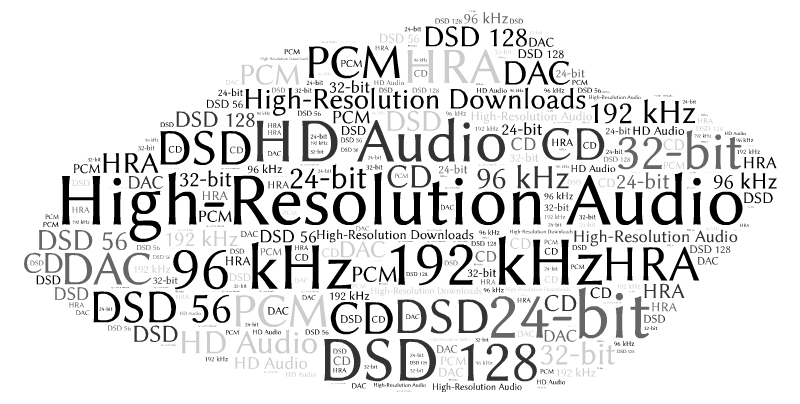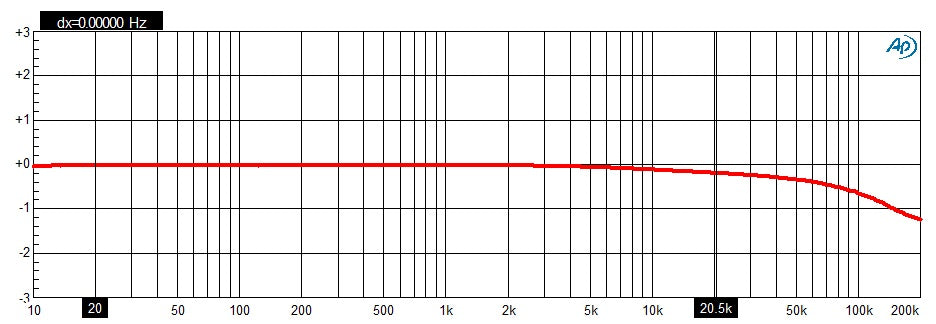Buy one component and save 10% on up to 2 cables. Buy 2 components and get 4 free cables. Free shipping on USA orders over $700.
Buy one component and save 10% on up to 2 cables. Buy 2 components and get 4 free cables. Free shipping on USA orders over $700.
What is High-Resolution Audio? - Part 2
by John Siau April 03, 2014

High-Resolution Audio systems offer the promise of an extended high-frequency range. High-Resolution digital systems now operate at 2 to 4 times the sample rate of the standard CD. This means that these systems have the capability of extending the playback frequency range well above the 22 kHz limit of the standard CD. Does this added high-frequency range improve our listening experience? How high is high enough? Do we really need anything over 20 kHz?
In the previous post I stated that "High-Resolution Audio will only truly arrive when the sum total of all defects in the audio chain become inaudible". In that post I discussed the need for low noise components. In this post I will look at frequency response. How much bandwidth do we need to satisfy the 20 Hz to 20 kHz limitation of the best human ears? Is a 20 kHz bandwidth good enough for High-Resolution Audio? If not, why not?
Let's assume we have a playback system consisting of a CD player, a preamplifier, a power amplifier and speakers. If each of these has a 20 Hz to 20 kHz frequency response, is this sufficient to reproduce all of the frequencies we can hear? The short answer is no. Here is why:
The frequency response of a system can be determined by summing the frequency response of each component in the audio chain. If two components are - 3 dB at 20 kHz, then together they are - 6 dB at 20 kHz. If we look at our example system, we have four components in the chain: CD player, preamplifier, power amplifier, and speakers. If all are -3 dB at 20 kHz, then we have a system response that is -12 dB at 20 kHz. Worse yet, this system will typically measure -4 dB at 10 kHz. This system will not come close to meeting the performance of our ears! Each individual component was well matched to the limitation of our ears, but as a system, these components cannot achieve anything resembling High-Resolution Audio.

If we want to accurately reproduce 20 kHz audio, the frequency response of each component must extend well beyond 20 kHz. For this reason, Benchmark products are engineered to achieve a 200 kHz to 500 kHz bandwidth. Is this excessive and unnecessary? To answer this, let's replace each of the four components in our sample system with components that have a 200 kHz bandwidth. The combined system now measures - 4 dB at 100 kHz, - 0.8 dB at 50 kHz, and about - 0.2 dB at 20 kHz. This simple 4-component signal chain achieves a 100 kHz bandwidth and is well-matched to the 96 kHz bandwidth of a 192 kHz digital sample rate. We could legitimately argue that the region between 20 kHz and 100 kHz may offer little musical content, and even if it does, we may not be able to detect its presence. The real benefit is that we have preserved the entire 20 Hz to 20 kHz bandwidth after passing through four audio components in a typical playback system.
Professional audio systems often have very long analog signal chains. These applications place difficult demands on the frequency response of each analog component in the chain. A chain of 16 analog components, each with a bandwidth of 20 kHz, will produce an overall response of about - 3 dB at 5 kHz. This is telephone quality at best! If the same system is built with 200 kHz components, the overall response will be - 3 dB at 50 kHz, and about -1 dB at 20 kHz. Benchmark's founder, Allen H. Burdick, identified this problem when investigating the poor performance of analog audio distribution within television facilities in the mid 1980's. Performance of these analog systems was improved significantly by increasing the bandwidth of the analog distribution amplifiers. More details on this subject can be found in chapter 3 of "A Clean Audio Installation Guide" by Allen H. Burdick. Modern video systems use digital audio distribution and are not subject to these cumulative effects.
In summary, very high bandwidth is required at each link in the audio chain if we want to assemble a High-Resolution system. Audio components and digital formats that just meet the requirements of the human ear may be entirely inadequate when connected together in a chain. The audio chain is nowhere near as strong as the weakest link!
Also in Audio Application Notes

How Loud is the Distortion from Your Power Amplifier?
by John Siau August 08, 2025
Would you put a Washing Machine in your Listening Room?
If the answer is no, you may be surprised to discover that the distortion produced by your power amplifier may be louder than the noise produced by a major appliance.
Don't believe me? Take a look at Stereophile's test reports:
We selected 7 power amplifiers from Stereophile's top list of recommended amplifiers.
We took Stereophile's "THD+N vs. Power" plots for each, and replotted the data in a format that shows the loudness of the THD+N at the listening position.
The results are shocking!
Amplifier THD+N is louder than expected!
The distortion from your amplifier may be louder than a washing machine on the spin cycle, or it may be totally silent. How does yours perform? The answer is hidden in Stereophile's THD+N plots.
This application note reveals the hidden truth:
"The Distortion from your Power Amplifier may be Louder than a Washing Machine!"
I know, it sounds crazy, but this is what the measurements show!

Interpolator Overload Distortion
by John Siau November 20, 2024
Most digital playback devices include digital interpolators. These interpolators increase the sample rate of the incoming audio to improve the performance of the playback system. Interpolators are essential in oversampled sigma-delta D/A converters, and in sample rate converters. In general, interpolators have vastly improved the performance of audio D/A converters by eliminating the need for analog brick wall filters. Nevertheless, digital interpolators have brick wall digital filters that can produce unique distortion signatures when they are overloaded.
10% Distortion
An interpolator that performs wonderfully when tested with standard test tones, may overload severely when playing the inter-sample musical peaks that are captured on a typical CD. In our tests, we observed THD+N levels exceeding 10% while interpolator overloads were occurring. The highest levels were produced by devices that included ASRC sample rate converters.

Audiophile Snake Oil
by John Siau April 05, 2024
The Audiophile Wild West
Audiophiles live in the wild west. $495 will buy an "audiophile fuse" to replace the $1 generic fuse that came in your audio amplifier. $10,000 will buy a set of "audiophile speaker cables" to replace the $20 wires you purchased at the local hardware store. We are told that these $10,000 cables can be improved if we add a set of $300 "cable elevators" to dampen vibrations. You didn't even know that you needed elevators! And let's not forget to budget at least $200 for each of the "isolation platforms" we will need under our electronic components. Furthermore, it seems that any so-called "audiophile power cord" that costs less than $100, does not belong in a high-end system. And, if cost is no object, there are premium versions of each that can be purchased by the most discerning customers. A top-of-the line power cord could run $5000. One magazine claims that "the majority of listeners were able to hear the difference between a $5 power cable and a $5,000 power cord". Can you hear the difference? If not, are you really an audiophile?

